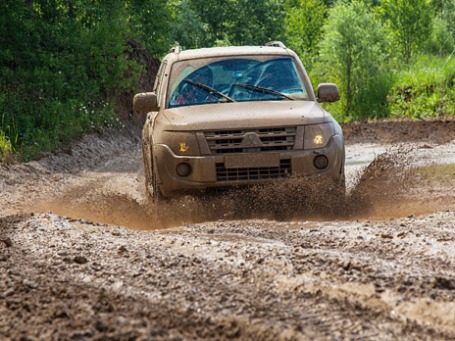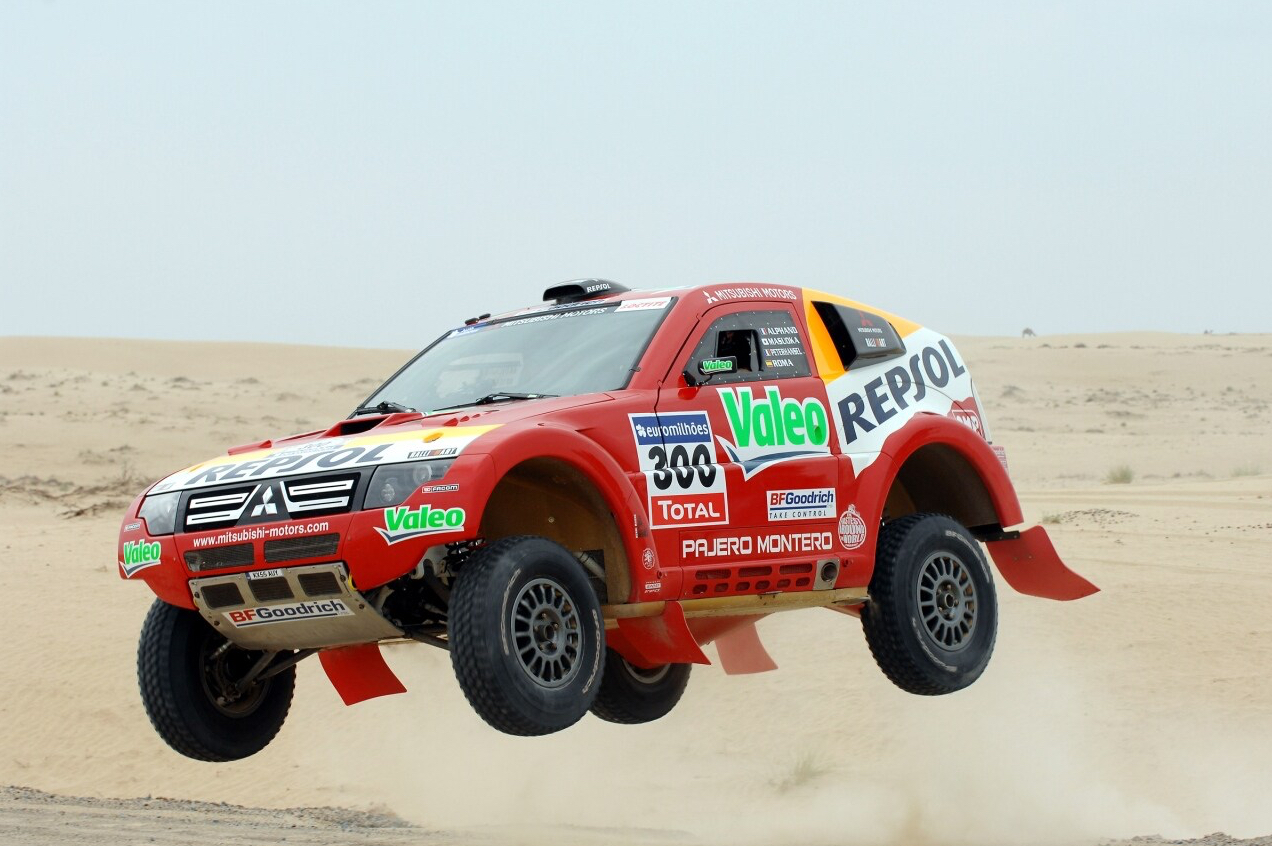- MITSUBISHI MOTORS’s second consecutive win and third overall victory
- Mitsubishi Pajero в Дакаре. 30 лет спустя
- Remembering the Dakar Pajero
- Dakar Pajero. Two words that went hand-in-hand for many years thanks to the success Mitsubishi had with its legendary 4×4 in the world’s toughest off-road race over many years throughout the 80s, 90s and noughties.
MITSUBISHI MOTORS’s second consecutive win and third overall victory
In September 1991, the Okazaki Proto No.3 was developed after a complete review of the basic specifications in order to increase its speed. Benefits such as aerodynamic performance, low driving position were validated, while a weight reduction program was undertaken, and reliability was further improved as well as durability. At the SBM facility, the wheelbase was extended compared to the 1992 model and the rims’ diameter was increased from 16 inches to 18 inches, with larger tire size. The changes improved maneuverability and, as a result of the comparison of the two cars, the decision was made to field the 1993 model developed by SBM on the basis of the high reliability shown by the test vehicle. A new high-low switching mechanism was added to the transfer box of the 6-speed transmission. The engine power was also increased to 340PS by adopting a new-generation ECU. During that year, the MITSUBISHI MOTORS team announced that Shinozuka, Weber, Saby and Fontenay would participate in the 1993 model PAJERO/MONTERO Prototypes. Masuoka and Ponsawan also entered with the T2 spec short wheelbase PAJERO/MONTERO version, which was equipped with a 2L 4G63 type gasoline turbo engine.
The Dakar Rally returned to Dakar for the first time in two years. In 1992, however, the number of cars that participated had dropped sharply to 159 due to the harshness of the event across the African continent and the emergence of the Paris-Beijing Rally across the Eurasian continent. That year’s course started at Trocadero Square in Paris, and for the first time, it landed in Africa at Tangier, a harbor city in northern Morocco. After that, the participants entered Algeria for the first time in five years. After a rest day in Adrar in the south of the country, they passed through Mauritania to Dakar in Senegal. The total distance was 7,490 km, and the competitive stages (SS) amounted to a short 4,818 km, but that included the longest and toughest special stage at 801 km.
The rally began with the four PAJERO/MONTEROs and five Citroën ZXs competing for the lead. The second competitive section was the stage between Beni Ounif and El Goléa, an oasis city in central Algeria. The sharp, rocky rough surface wreaked havoc on the vehicles with many forced to stop after running out of spare tires due to multiple punctures. PAJERO/MONTERO driver Saby, who took a careful approach to avoid punctures through this section, succeeded in taking the lead from Citroën’s Lartigue by 1 hour and 26 minutes. From then on, he kept up the pressure without slowing down his pace, handing the victory to MITSUBISHI MOTORS, winner for the second consecutive year, and giving the Japanese automaker its third victory. German rally driver Erwin Weber, who took 2nd overall in the previous event, finished a respectable fourth overall. All the prototypes completed the event with Shinozuka finishing fifth overall due to clutch problems and teammate Fontenay dropping to 12th overall. In the T2 specification PAJERO/MONTERO, Masuoka retired due to transmission trouble, but Thailand’s Ponsawan ranked 15th overall with his PAJERO/MONTERO entered in the modified production car class.
Mitsubishi Pajero в Дакаре. 30 лет спустя
В этом году компания Mitsubishi празднует 30-летний юбилей выступлений в легендарном ралли-рейде «Париж-Дакар». Главный виновник торжества — внедорожник Pajero, который в 1983 году, спустя год после запуска в производство стал участвовать в «Дакаре»
—>
В 2012 году компания Mitsubishi отмечала 30-летний юбилей своей, наверное, самой известной модели — внедорожника Pajero. Этим летом компания вновь отмечает круглую дату — 30 лет с тех пор, как тот самый Pajero впервые принял участие в легендарном ралли-рейде «Париж-Дакар».
В честь этого события в Москву приехал двухкратный чемпион «Дакара», легендарный гонщик, выступавший на Mitsubishi Pajero в течение 20 лет, Хироши Масуока.
Mitsubishi Pajero первого поколения дебютировал на Токийском автосалоне в октябре 1981 года, а в уже мае 1982 года в продажу поступила короткая трехдверная версия автомобиля. Через год появляется и пятидверная модификация с возможностью выбора из двух различных двигателей: 2,0-литровый турбированный бензиновый, а также 2,3-литровый турбированный дизель.
За всю историю «Париж-Дакар» Mitsubishi Pajero побеждал в престижной гонке в классе автомобилей массой менее 3500 кг 12 раз – это самое большое количество побед в зачете легковых автомобилей.
Он провел мастер-класс по управлению автомобилем на специально подготовленной трассе и прокатил всех желающих — в режиме гоночного такси.
Впервые Mitsubishi Pajero победил в ралли «Париж-Дакар» в 1985 году. После чего все больше участников ралли-рейда стали пересаживаться на эти автомобили. К слову, к концу 80-х более 10% всех машин, участвовавших в ралли (а их было около 360), были Mitsubishi Pajero. Всего же за всю историю участия Mitsubishi Pajero в ралли «Париж-Дакар», эти автомобили 12 раз побеждали в классе машин массой менее 3500 кг. Это самое большое количество побед в зачете легковых автомобилей, и рекорд не побит до сих пор.
«Главное в ралли — глаза. Работа с органами управления — это автоматизм. Главное видеть, что вас ждет впереди, далеко впереди. Тогда вы сможете пройти трассу быстрее всех и дойти до финиша. Впрочем, этот же принцип важен и в городе. Видеть перспективу, возможное развитие ситуации на дороге впереди», — заявил Хироши Масуока.
От слов, впрочем, он быстро перешел к делу, сев за руль новенького Pajero. Приятно наблюдать за тем, с какой легкостью человек управляется с тяжелой машиной. Разумеется, торможение левой ногой, быстрое руление и… контрруление. Машина боком несется по грунту, кажется, она сейчас уже перевернется, но у пассажиров даже нет сил вскрикнуть. И вот финиш. Следующий.
Японская компания отмечает юбилей выступлений в легендарном ралли
В этом году компания Mitsubishi празднует 30-летний юбилей выступлений в легендарном ралли-рейде «Париж-Дакар». Главный виновник торжества — внедорожник Pajero, который в 1983 году, спустя год после запуска в производство стал участвовать в «Дакаре»
В 2012 году компания Mitsubishi отмечала 30-летний юбилей своей, наверное, самой известной модели — внедорожника Pajero. Этим летом компания вновь отмечает круглую дату — 30 лет с тех пор, как тот самый Pajero впервые принял участие в легендарном ралли-рейде «Париж-Дакар».
В честь этого события в Москву приехал двухкратный чемпион «Дакара», легендарный гонщик, выступавший на Mitsubishi Pajero в течение 20 лет, Хироши Масуока.
Mitsubishi Pajero первого поколения дебютировал на Токийском автосалоне в октябре 1981 года, а в уже мае 1982 года в продажу поступила короткая трехдверная версия автомобиля. Через год появляется и пятидверная модификация с возможностью выбора из двух различных двигателей: 2,0-литровый турбированный бензиновый, а также 2,3-литровый турбированный дизель.
За всю историю «Париж-Дакар» Mitsubishi Pajero побеждал в престижной гонке в классе автомобилей массой менее 3500 кг 12 раз – это самое большое количество побед в зачете легковых автомобилей.
Он провел мастер-класс по управлению автомобилем на специально подготовленной трассе и прокатил всех желающих — в режиме гоночного такси.
Впервые Mitsubishi Pajero победил в ралли «Париж-Дакар» в 1985 году. После чего все больше участников ралли-рейда стали пересаживаться на эти автомобили. К слову, к концу 80-х более 10% всех машин, участвовавших в ралли (а их было около 360), были Mitsubishi Pajero. Всего же за всю историю участия Mitsubishi Pajero в ралли «Париж-Дакар», эти автомобили 12 раз побеждали в классе машин массой менее 3500 кг. Это самое большое количество побед в зачете легковых автомобилей, и рекорд не побит до сих пор.
«Главное в ралли — глаза. Работа с органами управления — это автоматизм. Главное видеть, что вас ждет впереди, далеко впереди. Тогда вы сможете пройти трассу быстрее всех и дойти до финиша. Впрочем, этот же принцип важен и в городе. Видеть перспективу, возможное развитие ситуации на дороге впереди», — заявил Хироши Масуока.
От слов, впрочем, он быстро перешел к делу, сев за руль новенького Pajero. Приятно наблюдать за тем, с какой легкостью человек управляется с тяжелой машиной. Разумеется, торможение левой ногой, быстрое руление и… контрруление. Машина боком несется по грунту, кажется, она сейчас уже перевернется, но у пассажиров даже нет сил вскрикнуть. И вот финиш. Следующий.
Remembering the Dakar Pajero
Dakar Pajero. Two words that went hand-in-hand for many years thanks to the success Mitsubishi had with its legendary 4×4 in the world’s toughest off-road race over many years throughout the 80s, 90s and noughties.
With news this last week that Mitsubishi will end production of the Pajero next year we thought we’d take a look back at the success the Japanese manufacturer had in the Dakar Rally over many years with its ‘family 4×4 wagon’.
First launched in 1982 as a three-door wagon, it wasn’t long before the Pajero made its debut in the Production and Marathon Class of the 1983 Paris Dakar Rally, an event that had been running since 1978 and was considered to be the world’s toughest off-road endurance competition. Both vehicles were close to standard, and they both finished the gruelling 10,000km event.
In its second run in 1984, Mitsubishi entered a vehicle in the Production-Modified Class and, piloted by Scottish rally driver Andrew Cowan, the Pajero went on to finish the 11,000km Paris-Alger-Dakar event in third place overall. Cowan went on to establish Mitsubishi Ralliart Europe.
On only its third attempt in 1985, the Pajero won the Paris-Dakar in the hands of Frenchman Patrick Zaniroli, with Andrew Cowan coming home in second place in another Pajero ahead of a Toyota 60 Series LandCruiser in third. This 1-2 finish earned the Pajero the title “King of the Desert”, and really proved the vehicle’s mettle in tough off-road conditions.
Porsche took out the Dakar in 1986, then Peugeot dominated the event for four years from 1987-1990, followed by Citroën in 1991.
Keen to take back its “King of the Desert” title, Mitsubishi got serious in 1992 and Hubert Auriol piloted his Pajero Evolution to the win. Pajeros also came home in second and third.
It was Bruno Saby’s turn in 1993, also in a Pajero Evolution.
Citroën fought back the next year and took out the event three times in a row in 1994, 1995 and 1996, before Mitsubishi Pajero Evolutions took out the event again in 1997 and 1998, first in the hands of Japanese driver Kenjiro Shinozuka (the first Japanese to win the race), and then in the hands of Frenchman Jean-Pierre Fontenay.
Schlesser Buggies won in 1999 and 2000 before Mitsubishi really stamped its dominance on the event, taking the win for the next seven consecutive years, from 2001 to 2007!
German driver Jutta Kleinschmidt became the only woman to ever win the Dakar when she crossed the line first in her Pajero Evolution in 2001. Hiroshi Masuoka’s Pajero Evolution won the next two events before six-time bike winner Stephan Peterhansel won the event in a Pajero Evolution in 2004, 2005 and 2007. Luc Alphand’s Pajero split Peterhansel’s run of successes in 2006.
There was no running of the Dakar in 2008 due to concerns over extremist activity in North Africa. The event was moved to South America for 2009 and Mitsubishi decided to participate under the Lancer nameplate rather than Pajero, without success.
In its 25 years of factory-backed participation in the Dakar, from 1983 to 2007, the Mitsubishi Pajero Evolution won the event an astonishing 12 times, making it by far the most successful Dakar Rally vehicle of all time. With a record like that the Pajero really does deserve the title “King of the Desert”.
The Pajero also had many successes in other off-road rallies around the world, including the Australasian Safari and the Australian Offroad Racing Championship.
See the video below to hear Japanese Dakar competitor Hiroshi Masuoka explain why the Pajero was so successful in off-road competition.






